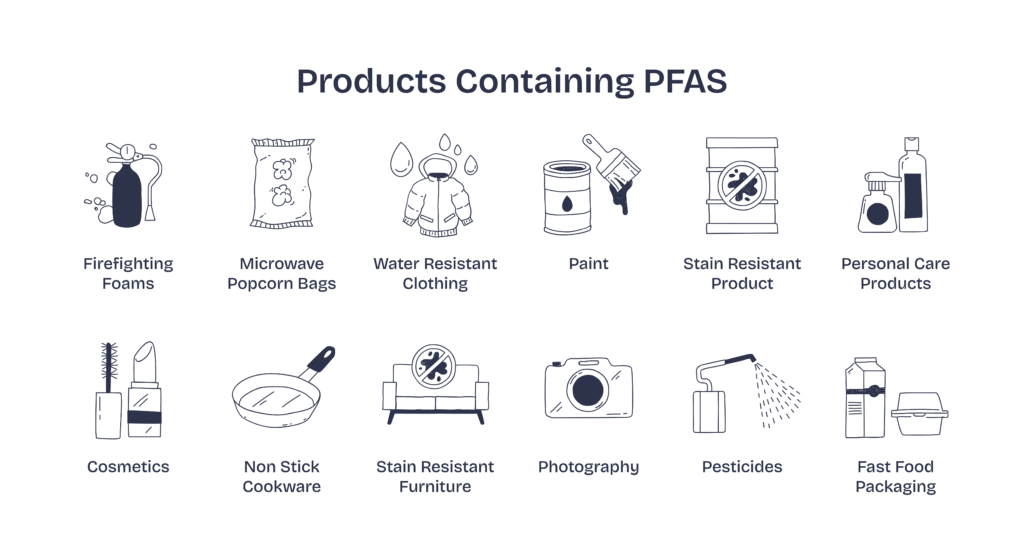Welcome to the world of per- and polyfluoroalkyl substances (PFAS), man-made, ultra-resistant chemicals found just about everywhere: in water-repellent clothing, non-stick cookware, food packaging, and even cosmetics. Their superpower? A unique molecular structure that gives them remarkable properties: water resistance, stain repellence, flame retardancy… In short, the perfect allies for consumer products. But this resistance comes at a cost, PFAS hardly break down. They build up in the environment, seep into water, air, soil… and eventually into our bodies. That’s why they’re often referred to as forever chemicals. Once hailed as revolutionary, PFAS are now raising serious concerns about their potential risks to human health.

How PFAS Became Ubiquitous in Consumer Products
Even though PFAS make our daily lives more convenient, they are not without health risks. Several studies have shown that these substances can have harmful effects on various organs, including the liver, kidneys, and thyroid. Over the long term, their presence in the body could lead to serious health consequences. Research has also linked PFAS exposure to fertility issues. In children, these substances may be associated with developmental delays or other negative effects on growth (Environmental Protection Agency (EPA), (2024), Our Current Understanding of the Human Health and Environmental Risks of PFAS, Link).
Understanding Our Lifetime PFAS Exposure
Let’s start with a key concept: the exposome. This term refers to the totality of exposures (environmental, dietary, chemical, or lifestyle-related) that a person experiences throughout their life. The exposome helps us better understand how these exposures can influence our health.
In the case of PFAS, the exposome includes exposure through food, air, soil, and drinking water. Beyond everyday exposure at home, some individuals are also exposed to PFAS in their workplace. This is particularly true for firefighters, whose flame-resistant gear and fire-fighting foam contains PFAS, as well as workers in the textile and food industries who may handle materials containing these substances.

Now that we understand what the exposome is, let’s take a closer look at how much PFAS is present in our bodies. One of the most reliable ways to measure this is through blood plasma analysis. Using mass spectrometry, PFAS can be detected and measured with high precision. With LDTD-MS/MS technology (Laser Diode Thermal Desorption coupled with tandem mass spectrometry), results can be obtained in just a matter of seconds.
After collecting a plasma sample, laboratory professionals perform a liquid-liquid extraction to isolate the compounds of interest. The sample is then placed on a support called a LazWell. Once dried, it is analyzed using a Luxon Ion Source, with an analysis time of less than 12 seconds per sample. As you can imagine, using LDTD-MS/MS technology significantly speeds up the pace of lab analyses thanks to these very short processing times compared to other technologies, such as liquid chromatography.
Thresholds, Guidelines, and Global Standards
Let’s get straight to the point: at what concentrations do PFAS become truly dangerous to our health? Although data on exact thresholds are still limited, experts are starting to get a clearer picture. According to a publication by the National Academies of Sciences, Engineering, and Medicine, effects have been observed once PFAS concentrations in plasma reach 2 ng/mL. Below this threshold, no significant impact is assumed. Between 2 and 20 ng/mL, effects are mainly seen in vulnerable populations. However, above 20 ng/mL, the risk becomes real for the entire population, highlighting the need for strict and continuous monitoring.
To better understand our actual level of exposure to PFAS, it’s helpful to refer to official guidelines set by various government agencies. In Canada, the maximum recommended concentration for a sum of 25 specific PFAS in drinking water is 30 ng/L. However, these values can vary from country to country. For example, the European Union sets a limit of 100 ng/L for a group of 20 PFAS, while the United States has taken a different approach, with an individual limit (not a group limit) of 4 ng/L for PFOS and PFOA, two of the most studied compounds.
However, exposure through drinking water remains relatively low compared to other sources, such as food consumption or contact with materials containing PFAS: non-stick cookware, food packaging, treated textiles, and even certain cosmetics.

Technologies and Regulations to Reduce PFAS Contamination
As you’ve seen throughout this article, PFAS (Per- and Polyfluoroalkyl Substances) pose a real challenge for public health. In response, many governments have stepped up by tightening regulations around their production, importation, and release into the environment. The goal is clear: to limit their presence and protect people from prolonged exposure to these persistent pollutants.
Innovative technologies are currently being developed to remove PFAS from drinking water. There are two main types of solutions: destructive technologies, which aim to break down the contaminants, and non-destructive technologies, which extract them without decomposing them. Each approach has its advantages and limitations, but the key takeaway is that research is making progress. Thanks to these advances, the hope for a sustainable solution to treat PFAS-contaminated water is becoming increasingly real.
The Ongoing Battle Against ‘Forever Chemicals’
Although PFAS (Per- and Polyfluoroalkyl Substances) concentrations in human plasma appear to have decreased in recent years (according to data from the Government of Canada), it remains essential to maintain rigorous monitoring. These analyses are key to assessing whether the measures implemented to reduce exposure are truly effective.
It is also crucial to continue research, both on exposome detection technologies and on methods for eliminating PFAS from the environment. Understanding their actual presence in the population and developing solutions to get rid of them remain top priorities for public health and environmental protection.